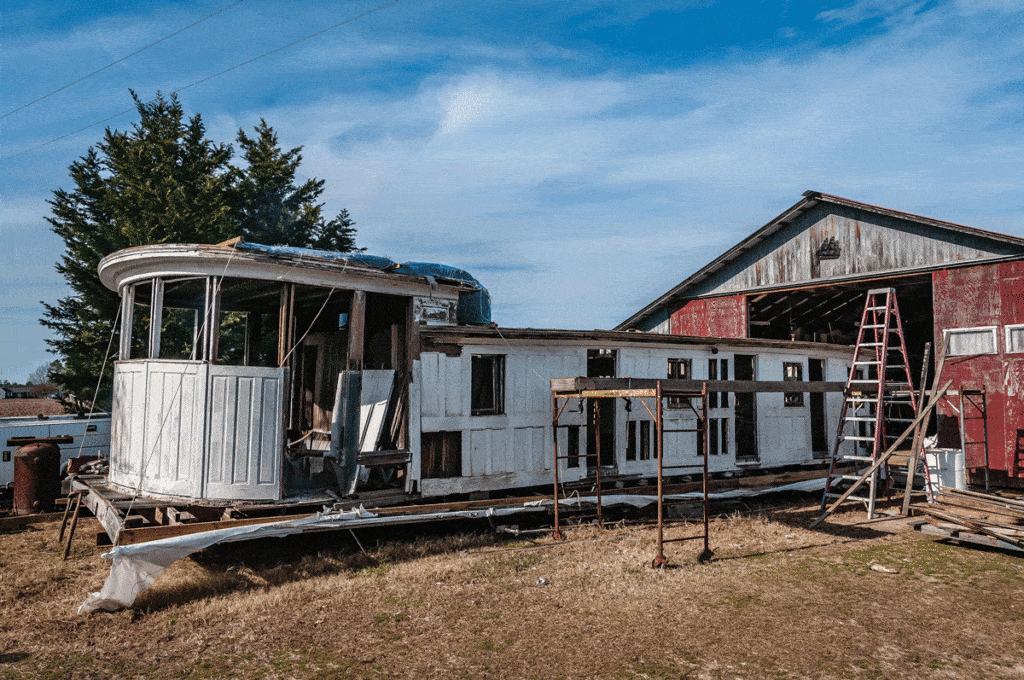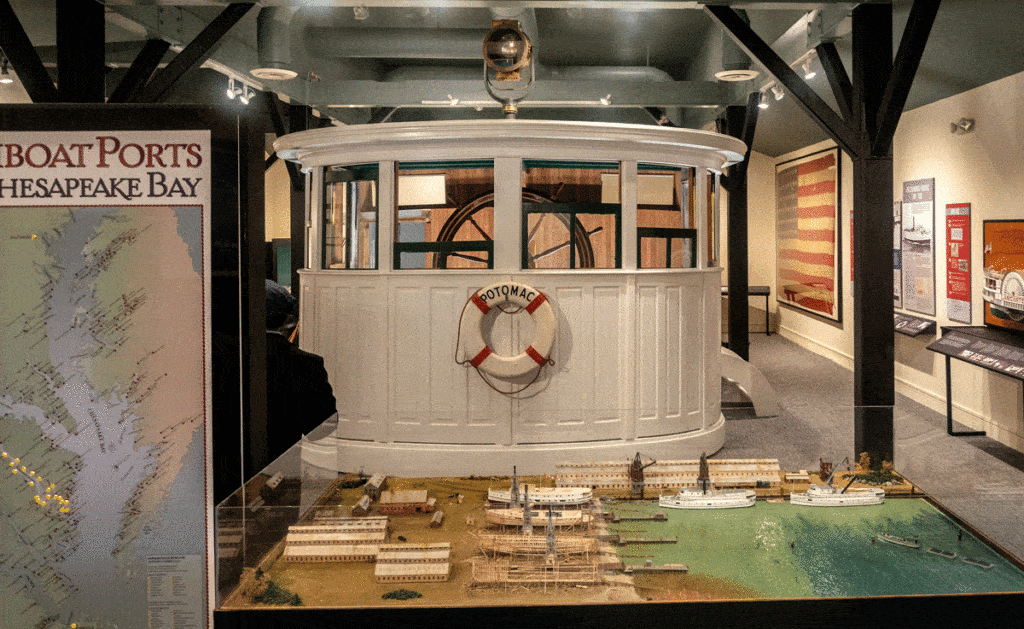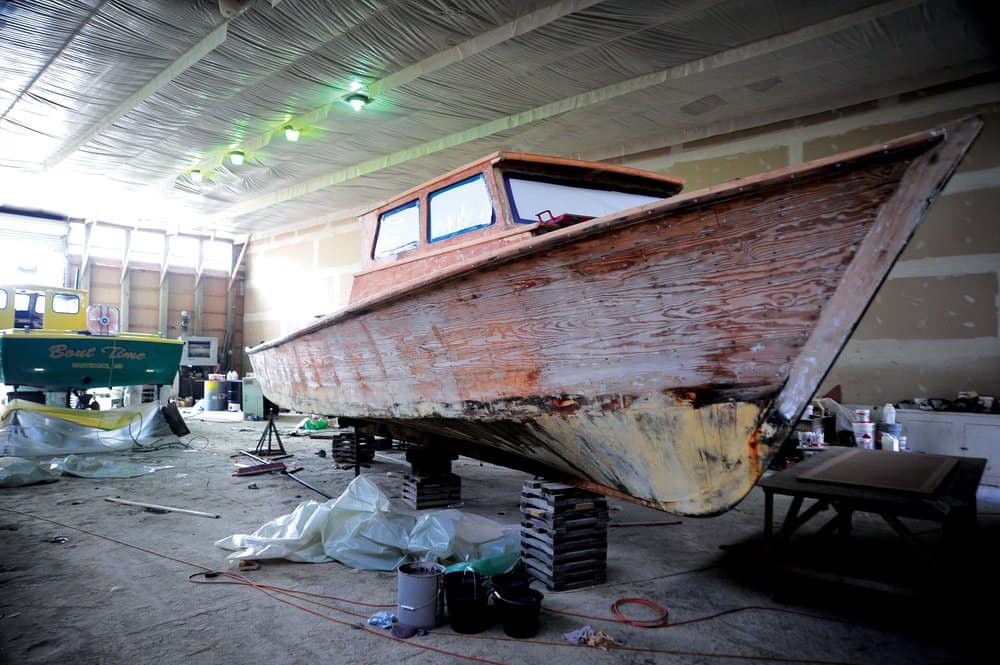A working steamship becomes a room with a view of history
It plied the waters of the Chesapeake, Potomac, and Rappahannock; spent a half-century disguised as a beach cottage; and for a few brief moments, even hung in the sky. This is the tale of the steamship Potomac, and of the little museum that finally brought it home.
Launched in 1894 by the Maryland and Virginia Steamboat Company, the Potomac was the picture of gracious water travel. White-coated stewards strolled the decks, and linen-covered dining tables were set with roses and gleaming silver. Passengers dined on fresh fish and oysters, served in sophisticated style by a waiter with a napkin draped over his arm. After a turn on the decks to watch the scenery go by, guests retired to one of the ship’s thirty-seven staterooms, where they slept on white-enameled wrought iron beds under candlewick spreads.
But the Potomac was more than upscale transportation—it was also the lifeline for small towns in Southern Maryland and Virginia’s Northern Neck, carrying everything from livestock to watermelons to shoes between big port cities and secluded farming communities. That all ended suddenly on February 27, 1936, when the Potomac was rammed by a freighter in heavy fog. The wooden superstructure and steel hull pierced above the water line, it was towed to port, then salvaged to become a pulpwood barge.
That might have been the last anyone heard of the Potomac but for Ben and Willoughby Colonna. The brothers, whose Norfolk shipyard was in charge of the refit, were so impressed by the steamship’s elegant pilothouse that they had it transported to their family’s Taft Beach fish factory in White Stone, Virginia. There it was hauled onto land and transformed into a guest cottage. Years passed, the factory changed hands, and the cottage was remodeled again to reflect its steamship origins. Of this restoration, Chesapeake Bay historian Richard H. Burgess, wrote, “It was as if the structure was still on the steamer…complete with steering wheel, binnacle, gong pulls, searchlights, name boards, and carved eagle on its top as decoration.”
Eventually the fish factory closed, and the property passed to relatives of Meredith Robbins, a menhaden fishing captain. He agreed to watch over the cottage, but while he was reassigned to a vessel in the Gulf, the Potomac pilothouse fell into disrepair. Paint peeled, vandals broke windows, and the last vestige of the once proud steamship became a popular spot for late night lovers’ trysts.
“From what our visitors tell us, you’d think everyone in the Northern Neck made out in the pilothouse,” jokes Barbara Brecher, Executive Director of the Steamboat Era Museum in Irvington.

After a fire destroyed the abandoned fish factory, the property owners donated the structure to the Mariners’ Museum in Newport News in hopes it could be saved. The pilothouse sat in storage for 13 years before the Collections Committee voted to donate her to the Colonial Beach Historical Society, returning the Potomac to the river for which it was named. But the Historical Society soon found the cost of renovation exceeded their budget. As fate would have it, a new museum dedicated to steamships was being founded in the little town of Irvington (population 404). Colonial Beach Historical Society offered the Potomac to the fledgling Steamboat Era Museum in 2001.
“For us, the pilothouse was like a dream come true,” recalled Jimmy Lee Crockett, one of the Museum’s early supporters.
As the largest remaining piece of an authentic Chesapeake steamboat, the pilothouse would be the Museum’s focal point—but making that dream a reality was a tremendous challenge. The cost to restore the pilothouse and redesign the Museum footprint to accommodate it was estimated at $350,000. Generous grants were awarded from the Wiley Foundation, the Carter C. Chinnis Charitable Trust, and the Mary Morton Parsons Foundation, and the community of the lower Northern Neck opened their hearts and wallets. Their commitment to the project can be found in the four-inch binder Brecher keeps in her office.
“It’s filled to capacity, and each page represents a donation,” she explains proudly.
Through a mix of grants and fundraisers, the Museum was able to raise nearly $400,000. Meanwhile, in December 2015, the pilothouse was transported to John Morgenthaler’s shop in Ophelia to begin work.
Three-and-a-half years later, the Potomac’s long odyssey ended. On a Wednesday morning in May 2019, a crowd watched as a 155-ton crane lifted the pilothouse high in the sky and then gently lowered her to the rear of the museum, where it is the centerpiece for a wide-ranging collection of artifacts and exhibitions detailing the role of the steamboat in Chesapeake history.
The Potomac had finally found her way home.




